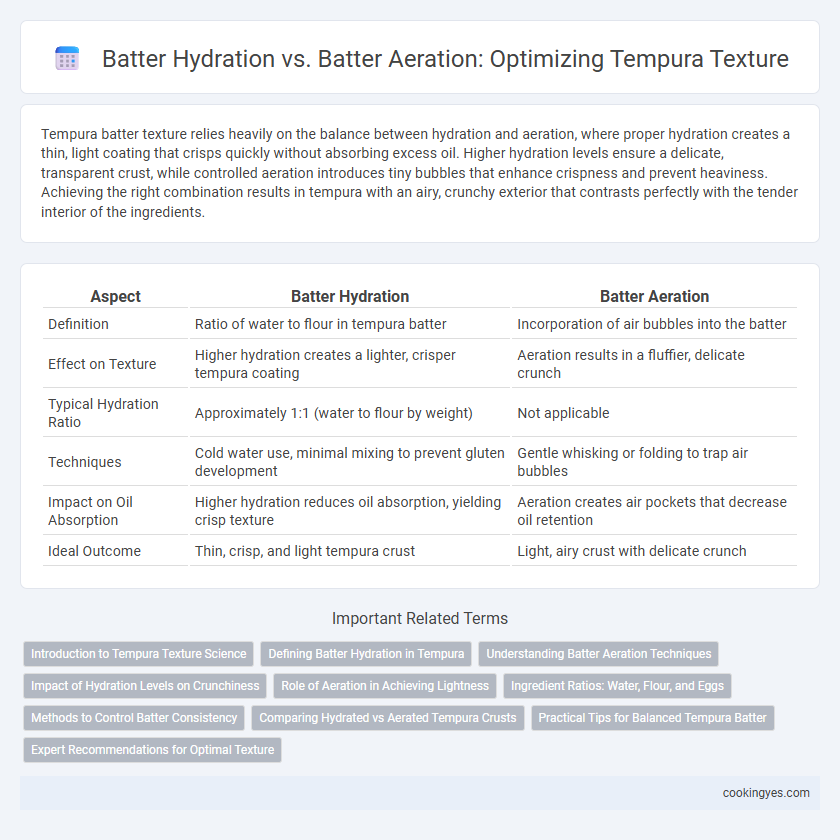Tempura batter texture relies heavily on the balance between hydration and aeration, where proper hydration creates a thin, light coating that crisps quickly without absorbing excess oil. Higher hydration levels ensure a delicate, transparent crust, while controlled aeration introduces tiny bubbles that enhance crispness and prevent heaviness. Achieving the right combination results in tempura with an airy, crunchy exterior that contrasts perfectly with the tender interior of the ingredients.
Table of Comparison
| Aspect | Batter Hydration | Batter Aeration |
|---|---|---|
| Definition | Ratio of water to flour in tempura batter | Incorporation of air bubbles into the batter |
| Effect on Texture | Higher hydration creates a lighter, crisper tempura coating | Aeration results in a fluffier, delicate crunch |
| Typical Hydration Ratio | Approximately 1:1 (water to flour by weight) | Not applicable |
| Techniques | Cold water use, minimal mixing to prevent gluten development | Gentle whisking or folding to trap air bubbles |
| Impact on Oil Absorption | Higher hydration reduces oil absorption, yielding crisp texture | Aeration creates air pockets that decrease oil retention |
| Ideal Outcome | Thin, crisp, and light tempura crust | Light, airy crust with delicate crunch |
Introduction to Tempura Texture Science
Tempura texture relies heavily on the delicate balance between batter hydration and aeration. High hydration levels create a thinner, lighter batter that crisps quickly, while proper aeration introduces microscopic air pockets essential for a fluffy, crackling crust. Understanding the interplay between water-to-flour ratios and mixing techniques is crucial for achieving the iconic tempura crunch and lightness.
Defining Batter Hydration in Tempura
Batter hydration in tempura refers to the ratio of water to flour in the batter, which directly influences the texture by affecting its viscosity and coating ability. Higher hydration levels create a thinner batter that crisps quickly, producing a light, delicate shell, while lower hydration yields a thicker, denser crust. Proper control of hydration is essential to achieving the signature airy, crisp texture characteristic of authentic tempura.
Understanding Batter Aeration Techniques
Batter aeration techniques for tempura involve incorporating air bubbles to create a light, crispy texture distinct from hydration levels, which primarily affect batter viscosity. Techniques such as gentle folding or minimal mixing help trap fine air pockets, enhancing the tempura's delicate crunch. Precise control over mixing speed and timing ensures optimal aeration without overdeveloping gluten, preserving the batter's tender structure.
Impact of Hydration Levels on Crunchiness
Higher hydration levels in tempura batter create a thinner coating that crisps up quickly during frying, resulting in a light, crunchy texture. Excessive water content can weaken the batter structure, leading to a less stable crust that absorbs more oil and becomes soggy. Optimal hydration balances moisture and flour, producing the signature tempura crunch by promoting rapid steam formation and minimal oil absorption.
Role of Aeration in Achieving Lightness
Aeration plays a crucial role in achieving the light, crisp texture characteristic of tempura by incorporating tiny air bubbles into the batter, which expand during frying to create a delicate crust. Proper batter aeration enhances the surface area's exposure to hot oil, promoting rapid moisture evaporation and preventing oil absorption for a non-greasy finish. In contrast, focusing solely on batter hydration without sufficient aeration can result in a denser, oilier tempura that lacks the signature fluffiness and crunch.
Ingredient Ratios: Water, Flour, and Eggs
Tempura batter texture depends heavily on the hydration level and aeration achieved through precise ingredient ratios: typically, a 1:1 ratio of ice-cold water to all-purpose flour creates a light, crisp coating. Incorporating one egg per cup of flour enhances batter binding and provides moderate aeration, contributing to a delicate, airy texture. Maintaining low hydration prevents sogginess, while gentle mixing preserves bubbles, balancing moisture content and aeration for an optimal tempura crust.
Methods to Control Batter Consistency
Controlling batter consistency in tempura relies heavily on balancing hydration and aeration to achieve the ideal texture. Hydration levels influence the batter's viscosity, with a thinner batter producing a lighter, crispier coating, while maintaining adequate aeration introduces tiny air pockets that enhance crispness and prevent heaviness. Methods such as adjusting water-to-flour ratios, using cold water to slow gluten development, and employing gentle mixing techniques help optimize batter hydration and aeration for perfect tempura texture.
Comparing Hydrated vs Aerated Tempura Crusts
Hydrated tempura batter retains moisture, creating a crisp yet tender crust that prevents oil absorption and promotes a light texture. Aerated batter incorporates air bubbles, resulting in a delicate, airy crust with enhanced crunchiness but potential for quicker staleness. Comparing hydration and aeration highlights the balance between moisture retention and crispness critical for the ideal tempura texture.
Practical Tips for Balanced Tempura Batter
Achieving the perfect tempura texture depends on balancing batter hydration and aeration to create a light, crisp coating. Use ice-cold water to keep the batter cold, preventing gluten development and ensuring a tender crust, while gently mixing to incorporate just enough air for crispiness without overbeating. Adjust the water-to-flour ratio to a slightly runny consistency, typically around 1:1, ensuring a thin, well-aerated batter that crisps quickly without becoming heavy or oily.
Expert Recommendations for Optimal Texture
Expert chefs recommend maintaining a high batter hydration of around 1:1 flour to ice-cold water ratio for tempura, ensuring a thin, fluid consistency that promotes light crispness. Aeration through gentle mixing is crucial to create tiny air bubbles, enhancing the delicate texture without overdeveloping gluten that leads to toughness. Optimal tempura batter achieves a perfect balance between hydration and aeration, resulting in a crispy exterior and tender interior, a hallmark of traditional Japanese frying techniques.
Batter hydration vs batter aeration for tempura texture Infographic

 cookingyes.com
cookingyes.com